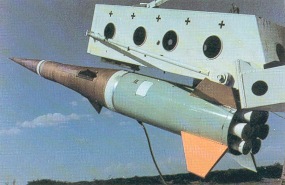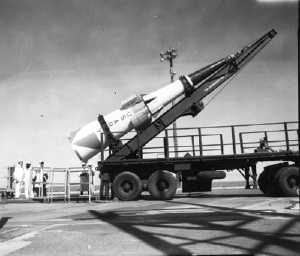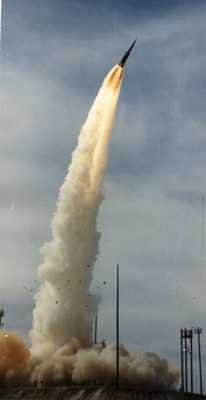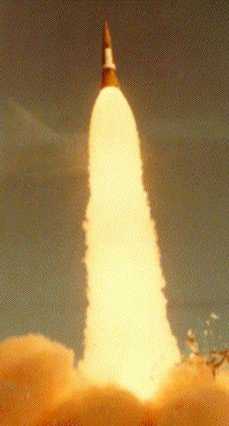Sprint
To say Sprint was a phenomenal missile, is putting it mildly. A
cone shaped missile that accelerated at 100g, achieved a speed of
Mach 10 in 5 seconds, had an ablative coating to dissipate the heat
that was generated from the fiction from the atmosphere and was so
accurate that the radar had to be de-tuned during testing so that
it would not hit incoming RVs. It was a phenomenal missile.
Sprint came about from a study that started in 1959 as a result
of identifying the need for a quick acting last ditch missile to
intercept incoming RVs, specifically those from sea-launched
ballistic missiles (SLBM) and to also intercept RVs that may have
got through the higher layer defence. It took three years of
research before the study concluded that with the use of phased
array radars and appropriate heat shielding, such a terminal
defence missile was possible. As a result, in January 1963, the DoD
directed that the Nike-X system be
developed which included not only the Nike-EX missile (subsequently Spartan), but also
another missile called Sprint. In March 1964, Martin Marietta was
awarded the development contract for the Sprint missile.
 No missile like Sprint is
created from a vacuum. Spartan came from years of development of
the Nike Zeus missile, and so various programs and other missiles
were used to assist the Sprint program. One program which ran
concurrently with Sprint for a short time was HiBEX (HIgh Boost EXperiment).
No missile like Sprint is
created from a vacuum. Spartan came from years of development of
the Nike Zeus missile, and so various programs and other missiles
were used to assist the Sprint program. One program which ran
concurrently with Sprint for a short time was HiBEX (HIgh Boost EXperiment).
Another program involved which was designed to test Sprint
components was called Squirt. It had a different booster to the
Sprint missile, but the second stage of the missile was comparable
to the Sprint missile. It was used during 196? at White Sands. Its
first flight was on 14 July 1964, with another six flights
following with at least one more in 1964. Some sources report that
flight testing of Sprint components started at White Sands early in
1964 with the first Sprint launch taking place in November 1965.
These early flights probably would have been of Squirt missiles
 Sprint was 'popped'
from its launch silo by a powder gas generator which propelled a
piston on which the missile rested. The missile was pushed through
a membrane at the top of the cell, while the piston is stopped at
the mouth of the silo. Once clear of the cell, the first stage was
ignited and the missile tilted over in the direction of the
incoming target. Aiming the missile so early in the trajectory
reduced the forces involved in moving the missile's trajectory and
allowed a very fast interception to take place. Some reports
indicate that the missile was supersonic by the time it left the
cell.
Sprint was 'popped'
from its launch silo by a powder gas generator which propelled a
piston on which the missile rested. The missile was pushed through
a membrane at the top of the cell, while the piston is stopped at
the mouth of the silo. Once clear of the cell, the first stage was
ignited and the missile tilted over in the direction of the
incoming target. Aiming the missile so early in the trajectory
reduced the forces involved in moving the missile's trajectory and
allowed a very fast interception to take place. Some reports
indicate that the missile was supersonic by the time it left the
cell.
The first stage had a short burning time, with the second stage
igniting 1.2 seconds after launch. Flight control during the 1st
stage burning is via fluid injection. Second stage control is
obtained via the small aerodynamic fins. Detonation of the warhead
was on ground command and was expected to be at an altitude of
between 1500m and 30,000m (5,000ft and 100,000ft). The incoming RV
was expected to be destroyed by both the nuclear blast, and the
high velocity neutrons. (The Sprint warhead was infact one of the
so called'neutron bombs' that caused so much controversy during the
1970s). The complete interception was expected to take less than 15
seconds.
Air friction alone during flight of the missile generated
temperatures of up to 3400°C (6200°F), and the ablative
heat shield could dissipate heat at rates up to 850 BTU/ft/sec.
Sprint was also constructed to withstand shocks up to 25,000Gs
which meant it could handle nearby nuclear explosions and their
resulting blast (how hardened it was to EMP and radiation is
unknown). When in flight, the missile was surrounded by a plasma
sheath which the command signals from the MSR were able to
penetrate. This was achieved due to the sheer high power of the MSR
(a beam that was less than 1 degree wide, and had a power of at
least 1MW).
Launches
There were two series of test launches of Sprint missiles. The
first series covered the initial development launches at White
Sands and then testing switched over to system and operational
launches at Kwajalein. This first series of launchers had 12 successes, with 2 partial successes and 2 failures. The second series of operational launches
took place at Kwajalein of which 29 were successful.
At Kwajalein, missile launches took place from Meck Island which
also had a MSR with a single phase array. However, in an
operational system Sprint could also be fired from a site which was
not co-located with the MSR. To test this capability, a second
Sprint launch facility was constructed on Illeginni Island which
was north of Meck Island. The first launch from this second site
took place in March 1972 and was successful.

| # |
Date |
Site |
Comments |
| Development Launches
|
| 1 |
November 1965 |
White Sands |
Successful. |
| 2 |
|
|
|
| 3 |
|
|
|
| 4 |
|
|
|
| 5 |
|
|
|
| 6 |
|
|
|
| 7 |
August 1970 |
White Sands |
??? Last development testing launch at White Sands. |
| Operational Launches |
| 8 |
23 December 1970 |
Kwajalein |
Intercepted an ICBM target nose cone. First actual target.
Successful. |
| 9 |
|
|
|
| 10 |
|
|
|
| 11 |
17 March 1971 |
Kwajalein |
First salvo launch. Two Sprints launched less than 1 sec apart
intercepted a Minuteman I RV launched from Vandenberg. |
| 12 |
|
|
|
| 13 |
|
|
|
| 14 |
|
|
|
| 15 |
|
|
|
| 16 |
|
|
|
| ?? |
7 May 1971 |
Kwajalein |
First intercept of a SLBM. Polaris launched from USS
Observation Island. |
2nd Series
| # |
Date |
Site |
Comments |
| 1 |
mid-1971 |
Kwajalein? |
|
| 2 |
|
|
|
| 3 |
|
|
|
| 4 |
|
|
|
| 5 |
|
|
|
| 6 |
|
|
|
| 7 |
|
|
|
| 8 |
|
|
|
| 9 |
|
|
|
| 10 |
|
|
|
| 11 |
|
|
|
| 12 |
|
|
|
| 13 |
|
|
|
| 14 |
|
|
|
| 15 |
|
|
|
| 16 |
|
|
|
| 17 |
|
|
|
| 18 |
|
|
|
| 19 |
|
|
|
| 20 |
|
|
|
| 21 |
|
|
|
| 22 |
|
|
|
| 23 |
|
|
|
| 24 |
|
|
|
| 25 |
|
|
|
| 26 |
|
|
|
| 27 |
|
|
|
| 28 |
|
|
|
| 29 |
|
|
|
| 30 |
|
|
|
| 31 |
|
|
|
| 32 |
December 1973 |
Kwajalein |
|
Specifications
Sprint was a a cone shaped missile, with four small fins
approximately 40% of the way up the missile near the base of the
2nd stage. Sprint was armed with an enhance radiation nuclear
warhead in the low kiloton range. This replaced a megaton warhead
which was canceled in 1968.
| Length: |
8.2m (27ft 0in) |
| Diameter: |
1.4m (4ft 6in) at base |
| Weight: |
3400kg (7,500lb) |
| Range: |
40km (25 miles) |
| Ceiling: |
30,000m (100,000ft) |
| 1st Stage Motor: |
Hercules solid (Approx 300,000kg thrust) |
| 2nd Stage Motor: |
Hercules solid |
| Guidance: |
Radio command |
| Warhead: |
Nuclear, low kiloton range |
Sprint II
Development and interest in Sprint did not end with the flight
testing of the missile. Martin was awarded a definition study
contract for Sprint II in May 1971. This was followed by a design
contract in October 1971. In May 1972 a contract worth $168 million
was signed for the development and flight testing of Sprint II. The
main improvements of the Sprint II missile included greater
accuracy, a manoeuvring capability three times greater than the
original Sprint, improved reliability, hardening and strengthening
against the increased manoeuvring forces and the final improvement
included a faster launch process. No known launches of Sprint II
were done, and investigations into such a missile were completed
during 1983 as non-nuclear forms of ABM defence started taking
precedence.

|
If Sprint was a phenomenal missile, HiBEX was even
more interesting in some ways. It was part of a project called
Defender run by DARPA in conjunction with the Army for a last ditch
ABM missile in a similar vein to Sprint. However, it was literally
a last ditch missile and was designed to intercept an incoming RV
at less than 6,100m (20,000ft) altitude. At that altitude, the
incoming RV would be traveling at around 3,000m/sec (10,000ft/sec)
so a very fast reaction time was essential to insure interception.
In fact, HiBEX was designed to have exited from its silo within 1/4
second and it accelerated at over 400g.
HiBEX was only 5.2m (17ft) long and due to the high
acceleration, the fuel did not last very long at all, so it was
characterised with very short rocket burn times and hence a very
short range. One of the problems with such a high accelerating
missile was that of guidance, and the onboard gyros presented a
problem. Mechanical gyros were not really practical due to the spin
up times and flight characteristics (ie they took to long to spin
up, and didn't take kindly to rapid shifts in trajectory), so ARPA
developed the laser gyro. This meant that the gyros and associated
guidance system was available essentially instantaneously
permitting a very rapid launch which was a major design goal.
HiBEX was not designed to use the MSR, but instead used another
radar called the HArd Point Demonstration Array Radar (HAPDAR).
All up, 7 missiles were tested at White Sands Missile Range
during 1965.
|
Last Modified: 27-Jan-2003
 No missile like Sprint is
created from a vacuum. Spartan came from years of development of
the Nike Zeus missile, and so various programs and other missiles
were used to assist the Sprint program. One program which ran
concurrently with Sprint for a short time was HiBEX (HIgh Boost EXperiment).
No missile like Sprint is
created from a vacuum. Spartan came from years of development of
the Nike Zeus missile, and so various programs and other missiles
were used to assist the Sprint program. One program which ran
concurrently with Sprint for a short time was HiBEX (HIgh Boost EXperiment). Sprint was 'popped'
from its launch silo by a powder gas generator which propelled a
piston on which the missile rested. The missile was pushed through
a membrane at the top of the cell, while the piston is stopped at
the mouth of the silo. Once clear of the cell, the first stage was
ignited and the missile tilted over in the direction of the
incoming target. Aiming the missile so early in the trajectory
reduced the forces involved in moving the missile's trajectory and
allowed a very fast interception to take place. Some reports
indicate that the missile was supersonic by the time it left the
cell.
Sprint was 'popped'
from its launch silo by a powder gas generator which propelled a
piston on which the missile rested. The missile was pushed through
a membrane at the top of the cell, while the piston is stopped at
the mouth of the silo. Once clear of the cell, the first stage was
ignited and the missile tilted over in the direction of the
incoming target. Aiming the missile so early in the trajectory
reduced the forces involved in moving the missile's trajectory and
allowed a very fast interception to take place. Some reports
indicate that the missile was supersonic by the time it left the
cell.
